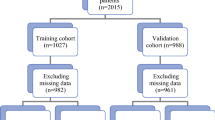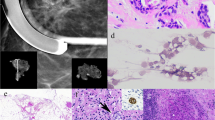Abstract
Sentinel lymph node (SLN) biopsy is a new standard of care for axillary node staging in breast cancer, which for the first time allows enhanced pathologic analysis on a routine basis. Although a number of retrospective studies, including our own series with 20-year follow-up, suggest that axillary nodal micrometastases found in this manner are prognostically significant, prospective trials now under way promise a definitive answer to this controversial subject. Enhanced pathology using serial sections and immunohistochemical staining identifies a high-risk minority of conventionally nodenegative patients who are converted to node-positive and thereby become candidates for systemic adjuvant chemotherapy. The developmental phase of SLN biopsy, now drawing to a close, has focused on the identification of this node-positive group. Enhanced pathology also identifies a majority of patients who are truly node-negative and whose expectation of long-term survival exceeds that of historic norms for node-negative breast cancer. The next era of SLN biopsy should focus on the characterization of this group. SLN biopsy in breast cancer has already extended the historic trend toward surgical conservatism. By defining more precisely a low-risk cohort of patients, SLN biopsy has the potential to initiate a trend toward medical conservatism as well.
Similar content being viewed by others
References
Morton DL, Wen DR, Wong JH, et al. Technical details of intraoperative lymphatic mapping for early stage melanoma,Arch Surg 1992;127:392–9.
Krag DN, Weaver DL, Alex JC, et al. Surgical resection and radiolocalization of the sentinel lymph node in breast cancer using a gamma probe,Surg Oncol 1993;2:335–40.
Giuliano AE, Kirgan DM, Guenther JM, et al. Lymphatic mapping and sentinel lymphadenectomy for breast cancer.Ann Surg 1994; 220:391–401.
Huvos AG, Hutter RV, Berg JW. Significance of axillary macrometastases and micrometastases in mammary cancer.Ann Surg 1971;173:44–6.
Breast. In: Fleming ID, Cooper JS, Henson DE, et al., eds.AJCC Cancer Staging Manual. Philadelphia: Lippincott-Raven, 1997: 171–8.
Attiyeh FF, Jensen M, Huvos AG, et al. Axillary micrometastasis and macrometastasis in carcinoma of the breast.Surg Gynecol Obstet 1977;144:839–42.
Rosen PP, Saigo PE, Bruan DW. Axillary micro and macrometastases in breast cancer. Prognostic significance of tumor size.Ann Surg 1981;194:585–91.
Dowlatshahi K, Fan M, Snider HC, et al. Lymph node micrometastases from breast carcinoma: reviewing the dilemma.Cancer 1997;80:1188–97.
International (Ludwig) Breast Cancer Study Group. Prognostic importance of occult axillary lymph node micrometastases from breast cancers.Lancet 1990;335:1565–8.
Cote RJ, Peterson HF, Chaiwun B, et al. Role of immunohistochemical detection of lymph-node metastases in management of breast cancer. International Breast Cancer Study Group.Lancet 1999;354:896–900.
Wilkinson EJ, Hause LL, Kuzma JF, et al. Occult axillary lymph node metastasis in patients with invasive breast cancer.Lab Invest 1983;44:83A.
Fitzgibbons PL, Connolly JL, Page DL. Practicing pathology cancer protocols: breast. College of American Pathologists Cancer Protocols 2003 (www.cap.org):1–30.
Greene FL, Page DL, Fleming ID, et al. Breast. In: Greene FL, Page DL, Fleming ID, et al., eds.AJCC Cancer Staging Manual. New York: Springer, 2002;221–40.
Giuliano AE, Dale PS, Turner RR, et al. Improved staging of breast cancer with sentinel lymphadenectomy.Ann Surg 1995;3:394–401.
Turner RR, Ollila DW, Krasne DL, et al. Histologic validation of the sentinel lymph node hypothesis for breast carcinoma.Ann Surg 1997;226:271–8.
Liberman L. Pathologic analysis of sentinel lymph nodes in breast carcinoma.Cancer 2000;88:971–7.
Weiser MR, Montgomery LL, Tan LK, et al. Lymphovascular invasion enhances the prediction of non-sentinel node metastases in breast cancer patients with positive sentinel nodes.Ann Surg Oncol 2001;8:145–9.
Turner RR, Chu KU, Qi K, et al. Pathologic features associated with nonsentinel lymph node metastases in patients with metastatic breast carcinoma in a sentinel lymph node.Cancer 2000;89:574–81.
Hill ADK, Tran KN, Akhurst T, et al. Lessons learned from 500 cases of lymphatic mapping for breast cancer.Ann Surg 1999;229:528–35.
Jakub JW, Diaz NM, Ebert MD, et al. Completion axillary lymph node dissection minimizes the likelihood of false negatives for patients with invasive breast carcinoma and cytokeratin positive only sentinel lymph nodes.Am J Surg 2002;184:302–6.
Tan LK, Giri D, Panageas K, et al. Occult micrometastases in axillary lymph nodes of breast cancer patients are significant: a retrospective study with long-term follow-up.Proc Am Soc Clin Oncol 2002;21:37a.
Grube BJ, Giuliano AE. Observation of the breast cancer patient with a tumor-positive sentinel node: Implications of the ACOSOG Z0011 trial.Seminin Surg Oncol 2001;20:230–7.
Krag DN, Harlow S, Weaver D, et al. Radiolabeled sentinel node biopsy: collaborative trial with the National Cancer Institute.World J Surg 2001;25:823–8.
National Institutes of Health Consensus Development Panel. National Institutes of Health consensus development conference statement: adjuvant therapy for breast cancer, November 1–3, 2000.J Natl Cancer Inst 2001;93:979–89.
Carlson RW, Anderson BO, Bensinger W, et al. The NCCN breast cancer guidelines in oncology.J Natl Comprehensive Cancer Network 2003;1:148–88.
Rosen PP, Groshen S, Saigo PE, et al. A long-term follow-up study of survival in stage I (T1N0M0) and stage II (T1N1M0) breast carcinoma.J Clin Oncol 1989;7:355–66.
Early Breast Cancer Trialists' Collaborative Group. Polychemotherapy for early breast cancer: an overview of the randomized trials.Lancet 1998;352:930–42.
Author information
Authors and Affiliations
Corresponding author
Rights and permissions
About this article
Cite this article
Cody, H.S., Borgen, P.I. & Tan, L.K. Redefining prognosis in node-negative breast cancer: Can sentinel lymph node biopsy raise the threshold for systemic adjuvant therapy?. Annals of Surgical Oncology 11 (Suppl 3), 227S–230S (2004). https://doi.org/10.1007/BF02523634
Received:
Accepted:
Issue Date:
DOI: https://doi.org/10.1007/BF02523634




